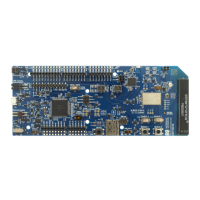Hardware description
You can set the VDD voltage to 1.8 V (default) or 3 V with SW11. Running 3 V GPIO with heavy load may
degrade the LTE RF performance. A third option for customizing VDD voltage level is applying a custom
voltage level to VIO_REF (P15). For more information, see GPIO - General purpose input/output in the
nRF9160 Objective Product Specification.
VDD powers most of the other circuits and will set the GPIO signal amplitude between nRF9160 and other
circuits on the board including connectors and PIN headers.
4.3.3 Other power domains
The interface MCU needs a 3.0 V for its USB interface supply, a low-dropout voltage regulator (U32) is used
for this. This regulator also supplies the LEDs on the board, giving these a fixed supply.
4.4 Antenna interfaces
nRF9160 DK has three antenna interfaces mounted representing LTE, GPS, and the 2.4 GHz radio.
The LTE and 2.4 GHz RF signals are propagated through two coaxial connectors with switches that will
disconnect the corresponding antenna from the radio if adapter cables are connected. This makes it
possible to perform conducted measurements or attach external antennas to the radio.
The GPS signal is RX only. There is a Low-Noise Amplifier (LNA) and a Band-Pass Filter (BPF) that amplify
and filter the signal before it is fed to the GPS RF port on the nRF9160. Switch SW12 controls if the input
signal to the LNA is connected to RF connector P29 or if the signal is routed from the GPS antenna A2
through switch U33. The LNA is connected to the GPS antenna by default.
The relation between the connectors, radios, and antennas are the following:
• J1 – Connector with a switch for the LTE antenna (A1)
• J7 – Connector with a switch for the 2.4 GHz antenna (A3)
• P29 – Connector for an external GPS antenna
For more details of the GPS antenna interface, see GPS on page 17.
4.5 GPS
The nRF9160 has a dedicated GPS port to support global navigation.
The GPS signal is received either from the onboard or an external GPS antenna. The onboard antenna (A2)
is connected to the combined LNA and BPF U3 through switches U33 and U34.
Figure 11: Onboard GPS antenna (A2), LNA/BPF (U3), connector P29, and switch SW12
4418_1216 v0.9.1
17

